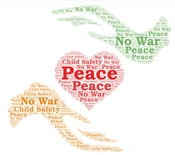Never aspire to confront your enemies (in a fight). Pray to God to be among those who seek to live peacefully with others. (Prophet Muhammad [PBUH])
Peace I leave with you; my peace I give you. I do not give to you as the world gives. Do not let your hearts be troubled, and do not be afraid. (Bible, John 14:27)
If we are to reach real peace in this world, and if we are to carry on a real war against war, we shall have to begin with the children. (Mahatma Gandhi)
Looking around, it seems that world wars, especially in the Middle East, have started again, and different stakeholders are launching their guns and still threatening each other with more bloodshed to come. Thousands of thousands have been displaced; thousands have been killed, and apart from the right of survival, many do not have the right to flee. Every war is brutal violence against children and a child rights and protection crisis. The condition and the capacity of the health services in the conflict zones are usually poor, and they cannot properly support the injured civilians, especially children.
In 2021, it was estimated that 450 million children in the world (one in six worldwide) were living in a conflict zone (1). Children receive a dramatic burden from armed conflicts by having developmental delay, physical injury, disability, behavioral consequences, and death. Over half of the 68.5 million forcibly displaced people in 2017 were children, and many of them had spent their entire childhood as displaced people (2).
In 1989, most of the countries committed by accepting the United Nations Convention on the Rights of the Child (3). Being exposed to violence will have immediate and long-term emotional and cognitive harmful effects on children (4).
In every war, children on any side of the conflict are the most vulnerable and the most silent victims. Armed conflicts and other forms of violence impose tremendous physical and psychological stress with sometimes irreversible consequences on children.
Children pay immediately for the economic and political conflicts and poverty of their community, and the wars cut their childhood short. Children may be easily separated from their parents or may lose them in armed conflicts. They can also provide the brightest of the dark future for their people. Adults create any war, but children are those who pay the most precious price: their life, their future, and even their hope for a better future.
The United Nations Convention on the Rights of the Child expresses that children should be protected against violence by the government (5). According to the Fourth Geneva Convention, the occupying power should not change the family or personal status of children (6, 7). Children may be forced to get involved in conflicts, and many times, they are obliged to become soldiers; even in this situation, they should also be considered children (8).
Protecting children's rights in conflict zones is a matter of global importance, and it involves various complex ethical, legal, and humanitarian issues. It is a moral responsibility and imperative that should be assured and guaranteed by the international community. Here are some points to consider.
1. Legal Framework: There is an international legal framework that governs children's rights during war. The United Nations Convention on the Rights of the Child (CRC) is a fundamental document in this regard. No matter where they live, their religion, who their families or parents are, or what their families or parents do or believe, children have all these rights. Being alive is every child's right. The survival and development of children in the best possible way is the responsibility of every government.
2. Impact of Conflict: Armed conflicts affect children. This can include physical harm, psychological trauma, displacement, loss of education, and family separation. These have long-term consequences of experiences on children's well-being and development. All children should be protected from these issues.
3. Child Soldiers: There is a significant violation of children's rights in conflict situations. The protection and safety of children during the war is their undeniable right. Children under 15 should be prohibited from taking part in war or joining the army.
4. Access to Education: It is important to ensure access to education for children affected by conflict. Many children are denied the opportunity to learn during wartime, which can have lasting effects on their future.
5. Protection Mechanisms: We have to protect children in conflict zones. The role of humanitarian organizations, peacekeeping missions, and advocacy groups is undeniable. Organizations like these collaborate to provide essential services, such as health care, clean water, a safe environment, and healthy food (3).
After all, there must be a strong commitment toward making hospitals and ambulances a secure zone that all governments, military, and militia forces are obliged to keep secure and guarantee/ ensure the safety of all hospital staff. Escalating attacks on civilians, especially children and hospitals, should be condemned, and everybody should call upon the governments, people, media, and international humanitarian organizations to insist on their ethical duty in order to bring a unified voice against brutality and violence against children all over the world.
